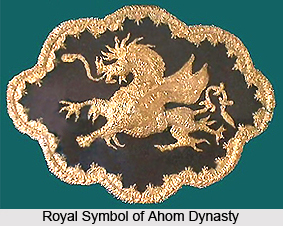 Tripartite struggle during Sudingphaa`s rule was witnessed among the Ahom ruler Sudingphaa (also known as Chandrakanta Singha), Purandar Singha and the Burmese. Following the Burmese invasion in the Ahom kingdom Sudingphaa fled to Guwahati. There he assembled soldiers and formed a troop for fighting against the Burmese who were confined in Upper Assam during that phase. At the same time Purandar Singha and Ruchinth Burhagohain were also involved in collecting soldiers for more than a year from Bengal, Goalpara and Bhutan and recruiting them in Duars, situated in the borders of Assam and Bhutan.
Tripartite struggle during Sudingphaa`s rule was witnessed among the Ahom ruler Sudingphaa (also known as Chandrakanta Singha), Purandar Singha and the Burmese. Following the Burmese invasion in the Ahom kingdom Sudingphaa fled to Guwahati. There he assembled soldiers and formed a troop for fighting against the Burmese who were confined in Upper Assam during that phase. At the same time Purandar Singha and Ruchinth Burhagohain were also involved in collecting soldiers for more than a year from Bengal, Goalpara and Bhutan and recruiting them in Duars, situated in the borders of Assam and Bhutan.
The army of Purandar Singha used to obtain guns and firearms with the help of Mr. Robert Bruce, the person accredited with the discovery of tea in Assam. In May 1821, Purandar Singha sent his fully equipped army to attack the force of Sudingphaa under the commandership of Mr. Robert Bruce. However his forces were gravely defeated by the army of Sudingphaa and the leader Mr. Robert Bruce was imprisoned by the victors. Later Sudingphaa released Robert Bruce owing to his agreement for supplying firearms and ammunitions to his soldiers. This news about the preparations on the part of Sudingphaa made the Burmese anxious and consequently in September 1821 the Burmese dispatched their troops towards Guwahati.
The huge size of the Burmese army scared Sudingphaa which resulted in his retreat from Guwahati to Hadirachowki, also called as Assam chowki, which is the westernmost outpost of Ahom kingdom in Assam. During this phase the western border of Ahom kingdom was guarded by Holiram Duariya Baruah, the officer in charge of Hadirachowki along with a garrison of three hundred Sikh soldiers. Holiram Duariya Baruah was the father of well known Assamese social worker, intellectual and reformer Anandaram Dhekial Phukan and was later appointed as Dhekial Phukan by Sudingphaa.
Holiram Duariya Baruah defended the attack of Burmese soldiers bravely along with his Sikh soldiers at Hadirachowki. However owing to the overpowering number of Burmese soldiers Holiram`s forces got defeated and he himself got injured in the battle with a rifle bayonet thrust. Subsequently Sudingphaa along with his followers moved across the border into the British territory, Goalpara district. Following their victory, the Burmese inflated their rule in other parts of Assam. They also received the submission of a number of tributary chiefs in Ahom rule including the ruler of Darrang. Only the tract between the Buri Dihing and the Brahmaputra, which is also referred to as Matak Kingdom, escaped the reign of Burmese and succeeded in maintaining their independence. During this phase Purandar Singha also marched towards Bhutan border to fight against the force of Sudingphaa after his defeat from the latter.



















